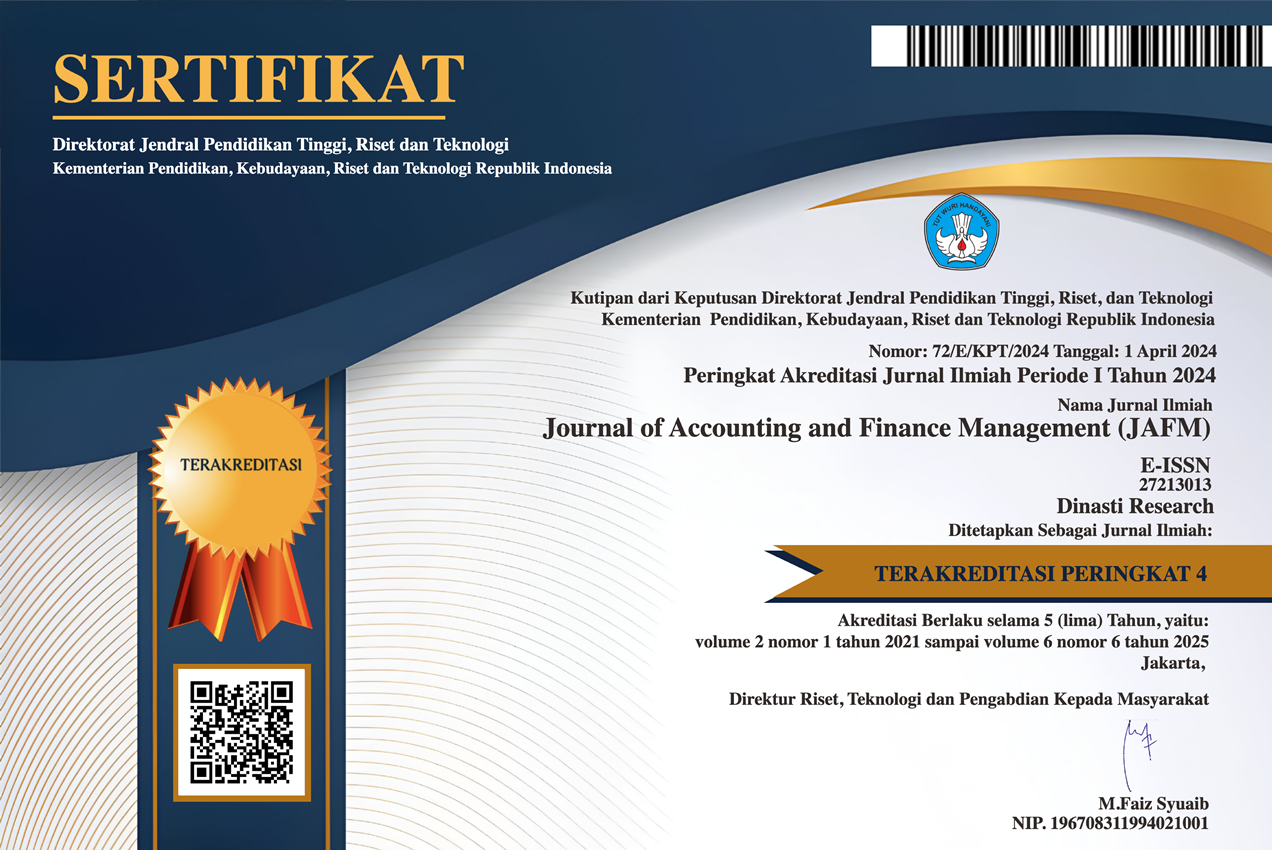The Role of Trust in Mediating the Influence of Perceived Value and Service Quality on Tenant Loyalty in Industrial Estates
DOI:
https://doi.org/10.38035/jafm.v6i3.2177Keywords:
Perceived Value, Service Quality, Trust, Tenant Loyalty, Industrial Estate, PLS-SEMAbstract
This study aims to examine the effect of perceived value and service quality on tenant loyalty in an industrial estate, with trust as a mediating variable. The research was conducted using a quantitative approach, involving 100 tenant respondents from a selected industrial area in Central Java, Indonesia. Data were analyzed using Partial Least Squares Structural Equation Modeling (PLS-SEM). The results show that perceived value and service quality have a significant direct effect on tenant loyalty. In addition, both variables significantly influence trust, which in turn positively affects tenant loyalty. Trust also plays a significant mediating role in the relationship between perceived value and service quality with tenant loyalty. These findings highlight the importance of building trust as a psychological bridge that transforms perceived value and service quality into sustainable tenant loyalty. This study contributes to the literature on business-to-business (B2B) relationship management and provides practical insights for industrial estate managers to strengthen tenant retention through trust-based strategies.
References
Anderson, E.W. and Sullivan, M.W. (1993), “The antecedents and consequences of customer satisfaction for firms”, Marketing Science, Vol. 12 No. 2, pp. 125–143.
Boulding, W., Kalra, A., Staelin, R. and Zeithaml, V.A. (1993), “A dynamic process model of service quality: from expectations to behavioral intentions”, Journal of Marketing Research, Vol. 30 No. 1, pp. 7–27.
Chen, C.F. and Tsai, M.H. (2007), “How destination image and evaluative factors affect behavioral intentions?”, Tourism Management, Vol. 28 No. 4, pp. 1115–1122.
Cronin, J.J. and Taylor, S.A. (1992), “Measuring service quality: a reexamination and extension”, Journal of Marketing, Vol. 56 No. 3, pp. 55–68.
Fullerton, G. (2005), “The impact of brand commitment on loyalty to retail service brands”, Canadian Journal of Administrative Sciences, Vol. 22 No. 2, pp. 97–110.
Garbarino, E. and Johnson, M.S. (1999), “The different roles of satisfaction, trust, and commitment in customer relationships”, Journal of Marketing, Vol. 63 No. 2, pp. 70–87.
Hair, J.F., Hult, G.T.M., Ringle, C.M. and Sarstedt, M. (2019), A Primer on Partial Least Squares Structural Equation Modeling (PLS-SEM), 2nd ed., Sage Publications, Thousand Oaks, CA.
Hasan, H., Abdullah, R., Abd Rahman, N.S.F. and Abd Rahman, R. (2020), “The mediating effect of trust on the relationship between service quality and customer loyalty”, Management Science Letters, Vol. 10 No. 13, pp. 2923–2930.
Kaura, V., Prasad, C.S.D. and Sharma, S. (2015), “Service quality, service convenience, price and fairness, customer loyalty, and the mediating role of customer satisfaction”, International Journal of Bank Marketing, Vol. 33 No. 4, pp. 404–422.
Kotler, P. and Keller, K.L. (2016), Marketing Management, 15th ed., Pearson Education Limited, Harlow.
Lemon, K.N. and Verhoef, P.C. (2016), “Understanding customer experience throughout the customer journey”, Journal of Marketing, Vol. 80 No. 6, pp. 69–96.
Morgan, R.M. and Hunt, S.D. (1994), “The commitment-trust theory of relationship marketing”, Journal of Marketing, Vol. 58 No. 3, pp. 20–38.
Oliver, R.L. (1999), “Whence consumer loyalty?”, Journal of Marketing, Vol. 63, Special Issue, pp. 33–44.
Parasuraman, A., Zeithaml, V.A. and Berry, L.L. (1988), “SERVQUAL: a multiple-item scale for measuring consumer perceptions of service quality”, Journal of Retailing, Vol. 64 No. 1, pp. 12–40.
Pham, T.S.H., Nguyen, N., Tu, P.A. and Tran, X.H. (2023), “Customer engagement, service quality, and loyalty in the hotel industry: the mediating role of satisfaction”, International Journal of Hospitality Management, Vol. 114, 103502.
Qiu, N., Lin, Z., Wang, J. and Zhang, H. (2024), “The impact of perceived value on tourist satisfaction and loyalty in industrial heritage tourism”, Heliyon, Vol. 10 No. 3, e37184.
Rahi, S., Ghani, M.A., Alnaser, F.M. and Ngah, A.H. (2022), “A structural equation model for evaluating customer loyalty based on perceived value, trust, and commitment in mobile banking context”, Future Business Journal, Vol. 8 No. 1, pp. 1–13.
Rather, R.A., Hollebeek, L.D. and Rasoolimanesh, S.M. (2022), “First-time versus repeat tourism customer engagement, experience, and value co-creation: A service-dominant logic perspective”, International Journal of Contemporary Hospitality Management, Vol. 34 No. 3, pp. 1160–1180.
Setiawan, H., Hati, S.R.H. and Safira, N.A. (2023), “Exploring service quality, customer trust and satisfaction in B2B relationships”, Journal of Relationship Marketing, Vol. 22 No. 1, pp. 1–19.
Tjiptono, F. (2017), Strategi Pemasaran, Edisi 4, Andi, Yogyakarta.
Wang, Y., Lo, H.P., Chi, R. and Yang, Y. (2004), “An integrated framework for customer value and customer-relationship-management performance: a customer-based perspective from China”, Managing Service Quality, Vol. 14 No. 2/3, pp. 169–182.
Zeithaml, V.A. (1988), “Consumer perceptions of price, quality, and value: a means-end model and synthesis of evidence”, Journal of Marketing, Vol. 52 No. 3, pp. 2–22.
Downloads
Published
How to Cite
Issue
Section
License
Copyright (c) 2025 Tri Bayu Pamuji, Weni Novandari, Larisa Pradisti

This work is licensed under a Creative Commons Attribution 4.0 International License.
Authors who publish their manuscripts in this journal agree to the following conditions:
- The copyright on each article belongs to the author(s).
- The author acknowledges that the Journal of Accounting and Finance Management (JAFM) has the right to be the first to publish with a Creative Commons Attribution 4.0 International license (Attribution 4.0 International (CC BY 4.0).
- Authors can submit articles separately, arrange for the non-exclusive distribution of manuscripts that have been published in this journal into other versions (e.g., sent to the author's institutional repository, publication into books, etc.), by acknowledging that the manuscript has been published for the first time in the Journal of Accounting and Finance Management (JAFM).



























